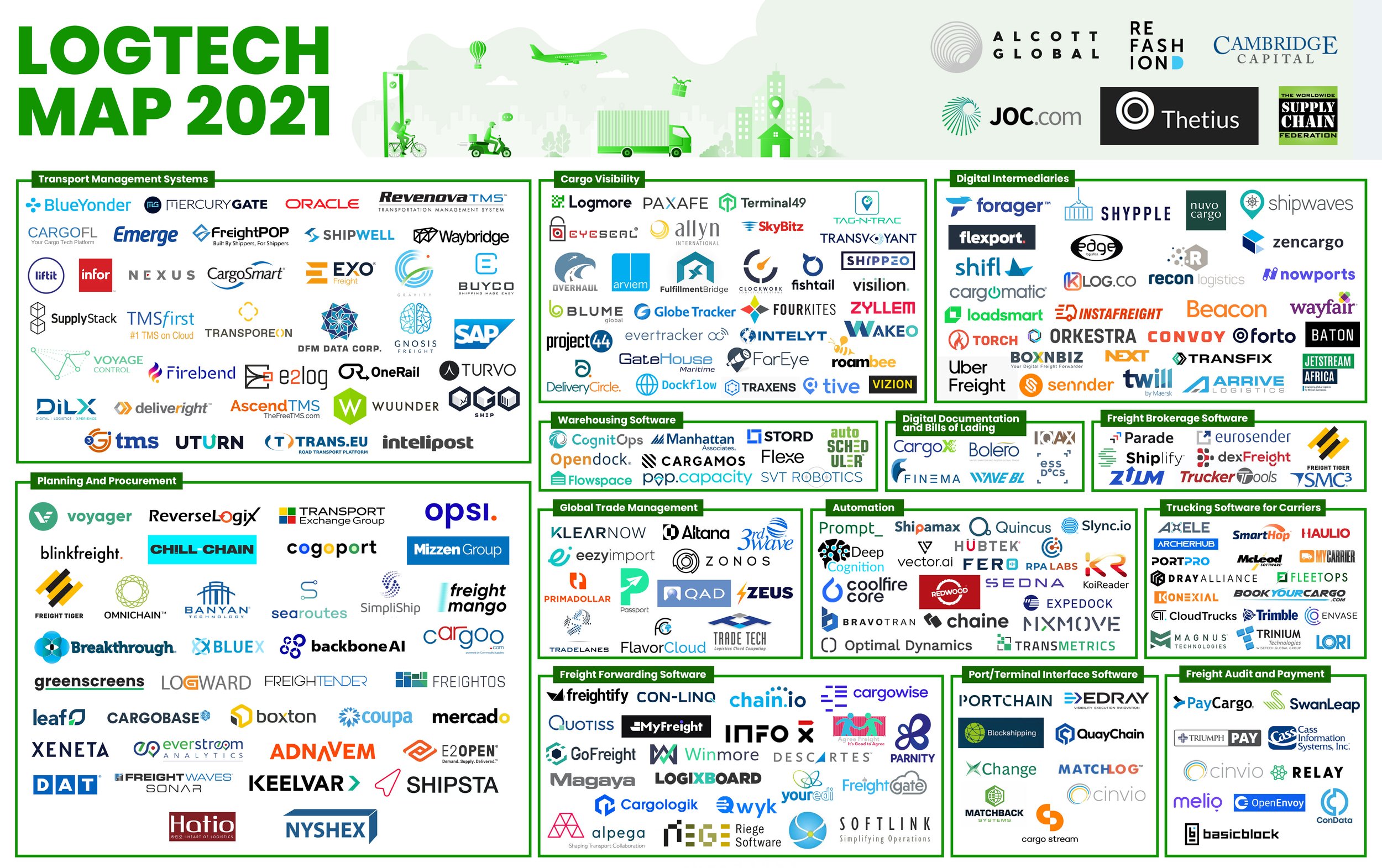New Logistics Technology Market Map Seeks to Center Buyers of Logistics Technology and Services
Volunteer group develops first open-source effort to map technology innovations for global supply chain logistics.
Press Release from REFASHIOND Ventures & The Worldwide Supply Chain Federation
For immediate Release: November 22, 2021
LogTech Market Map 2021
Today, a group comprising representatives of Alcott Global, Cambridge Capital & BGSA, The Journal of Commerce (JOC) & IHS Markit, Thetius, and REFASHIOND Ventures & The Worldwide Supply Chain Federation released a market map of technology innovations for the global supply chain and logistics market.
The market map is the first open-source effort to develop a view of what is happening in the global logistics technology landscape, a topic that has become of growing concern and relevance as the COVID-19 pandemic has put global supply chains under severe strain.
The global logistics space, a major component of international supply chains, is a massive market that underpins 100% of global GDP. As a result of its size and scope, the best way to develop a comprehensive view of what is happening is through a collaborative and open-source effort that enables actors in different parts of the market to contribute their knowledge and expertise.
“Logistics technology has never been more important,” said Benjamin Gordon, Cambridge Capital Managing Partner. “And the supply chain world is comprised of tens of thousands of experts, innovators and practitioners. We wanted to create the first-ever crowd-sourced logtech market map so that supply chain leaders can share their ideas, and facilitate an ongoing dialogue with potential customers, partners, and peers.”
“Market maps are not easy to put together, as this group discovered during the course of producing the LogTech Market Map, but they are incredibly valuable for the industries they serve,” said Eric Johnson, Senior Editor, Technology at Journal of Commerce. “In this case, the intention was to create a reference point for buyers based on logical segments of software offered to various types of buyers. We hope the map serves as a piece of the technology investment puzzle for buyers tasked with an expanding and confusing market.”
The market map is available for people who wish to download it here: https://sites.google.com/view/logtechmap2021/home
Additional information about the map is available in the following FAQs.
Media Inquiries: Reach out to one of the individuals listed at the end of the FAQs.
LogTech Market Map 2021 FAQs
Introduction: This map is an attempt to organize activity in the supply chain logistics technology (LogTech) market in a way that is relatively easy to understand for buyers of logistics technology products and services. It is not an attempt to organize a comprehensive list of logtech companies, nor is it a map focused on merely highlighting the major players in global logistics - there are many other excellent sources of information about those two questions.
This map is being developed with an eye towards highlighting areas in which there appears to be a lot of innovation happening. Some of this innovation involves new technology, new business models, or new business processes. Some of the innovation involves old technology put to a new use. Much of this activity is reflected in the news about supply chain logistics. This map is being developed by a small team of volunteers in an open-source, crowd-sourced, public, and iterative process. The goal is to create a useful final product for various constituents of the global supply chain logistics community. This is the latest version of the market map, but our goal is to keep improving it with updates every two years.
Here are a few Frequently Asked Questions about this market map, and the accompanying answers.
Who is this map for?
Ideally, over the course of time, this map will become an authoritative guide for anyone interested in learning more about global supply chain logistics either because they are:
An executive at a shipper seeking to procure logistics services for their company;
An industry executive just seeking to learn more about activity outside their own domain of expertise;
A student learning about supply chain logistics for the first time;
A technology entrepreneur seeking to gain a better understanding about how the innovation they are creating fits into the big picture landscape of global logistics, or;
A generalist investor seeking to understand supply chain logistics better in order to pursue investment opportunities.
What is the process for determining who gets included on the map?
Inclusion in the map is primarily determined by someone at a company that wishes to be featured filling out a data-intake form. In a few cases information provided via the data-intake form is supplemented with other information gathered by the team based on our collective prior experience. However, inclusion in the map is driven mainly by the opt-in completion and submission of information through the data-intake form.
Is this a map for pure software companies only, or also for services companies with technology?
This is a map of companies whose business models are dependent on technology as a source of differentiation, and for whom that technology serves as an important revenue driver. What does that mean? A company that develops technology solely for internal use, but that mainly sells management consulting services to outside customers does not belong on this map. A company that mainly sells technology to outside customers, and that sells ancillary consulting services to accompany the technology product would be a candidate for this map.
What are the criteria for inclusion in the logtech market map?
Our goal is to create a final map that is especially useful for buyers of logistics technology products and services as they try to determine where they might look for new innovations and technology to help them solve the problems they face in each of their companies. Typically these are executives at beneficial cargo owners (BCOs). We believe that if we accomplish that goal, we would have created a map that is useful for every other category of users of this map as well.
Given the information submitted through the form, our team tried to home in on companies we think have reached a relatively sustainable or stable state, and that are capable of taking on new customers. Generally, companies reporting the following data appear on the map;
Companies reporting annual revenues of $5.0M or more,
Companies reporting a team of 10 or more people, annual revenues of $1.0M, and an existing customer base of 10 or more customers,
Companies reporting a small team, no revenues yet, but 50+ customers,
Companies that fall somewhere in between those bookends, based on reported information, or in the minority of cases where a company is on the map without a submission - based on information from credible public sources.
Amount of investment capital raised, in and of itself, is not a reason for a company to be included on the map.
Given the nature of this process we are reliant on companies being honest in their submissions. We expect that outright dishonesty will eventually be exposed by the crowd and in such cases we will correct the map over time. That being said, we recognize the potential for abuse and are taking steps to guard against blatant attempts to abuse the process. More on that below.
How did you choose these categories?
We chose the categories based on our collective experience monitoring areas in which there’s a lot of activity taking place. We have limited the scope of the map in order to keep it from becoming too complex, and therefore less useful. We may expand the categories in future versions of the map - and perhaps we’ll have different maps for different functional domains within supply chain logistics.
If I don’t agree with a company’s listing, or location, can I propose voting it out?
Yes. However, final decisions about the map itself rest with the team building it. We encourage you to provide your feedback and comments through our feedback form. Also, you are free to comment on public discussion forums. We welcome constructive criticism; That’s the only way we will get this right.
Who created this map?
The following people volunteered their time to collaborate on creating this map, starting in April 2021
Brian Aoaeh (@brianlaungaoaeh), CFA, Cofounder & General Partner, REFASHIOND Ventures and, Cofounder, The Worldwide Supply Chain Federation
Nick Chubb (@nachubb), Founder & Managing Director, Thetius
Ben Gordon (@benjaminhgordon), Founder & CEO, Cambridge Capital, and BGSA
Eric Johnson (@LogTechEric), Senior Editor, Technology at Journal of Commerce (JoC), and IHS Markit
Radu Palamariu (@PalamariuRadu), Managing Director, Europe & Asia Pacific, Global Practice Head, Supply Chain & Logistics, Alcott Global

